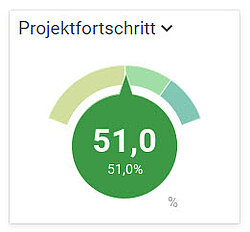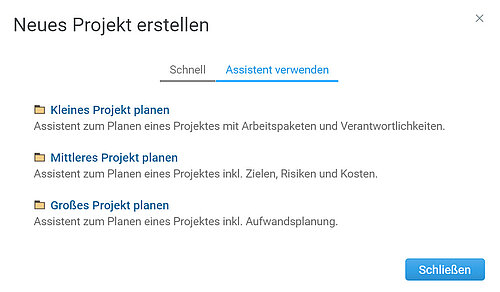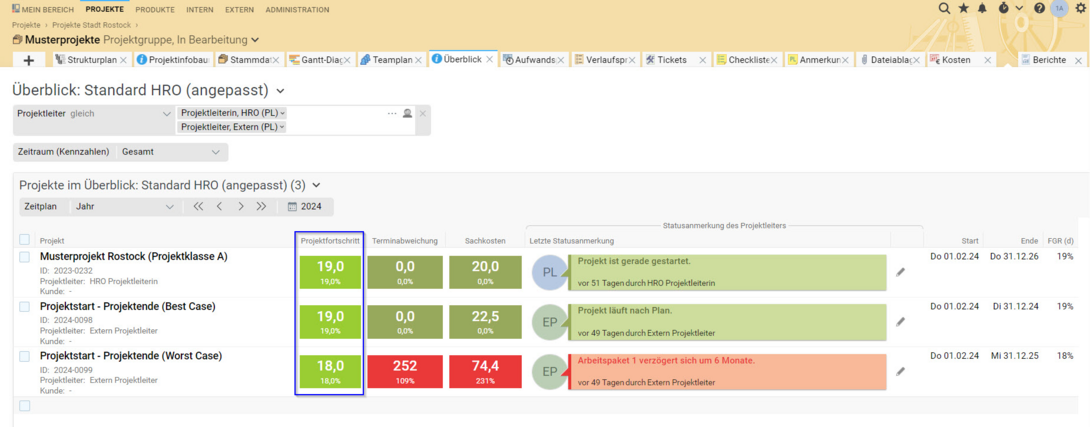Projektron BCS in use for digitization
Success story from of the Hanseatic and University City of Rostock, The Lord Mayor, Office for Digitization and IT
Projektron BCS impressed us with its granular assignment of rights and roles as well as its flexibility. The functions for creating work breakdown structures and generating reports also stood out positively. Projektron BCS offers us the possibility of mapping our small projects as well as managing large projects within the framework of programs with several individual projects and sub-projects.
Project management in the Rostock city administration
The range of tasks of a city administration is characterised to a large extent by line activities. This ensures, for example, the permanent provision of certain services to customers.
In recent decades in particular, however, the administration has also been expected to continuously develop alongside the fulfilment of mandatory tasks. Digitalisation is just one of many keywords here. In order to maintain a high quality of service, for example, services must also be offered in digital form. Today, a modern municipal administration is expected to think innovatively and adapt to social change. In order to ensure such further development, working in projects is of particular importance. Projects make it possible to address selected focal points within the framework of specially created "project organisations" and to achieve the goals set for them.
The project work of the city administration has to deal with two special framework conditions:
Firstly:
The city administration is characterised by a strong line hierarchy. In the Hanseatic and University City of Rostock, this is divided into more than 30 organisational units. The implementation of further development measures often requires cooperation between several organisational units. Project teams that operate outside this hierarchy must be able to act accordingly.
Secondly:
There is often no classic customer-supplier relationship as in other companies. The project output is usually generated for the residents or for the city administration itself. Requirements do not always arise in the sense of profit maximisation, but can be defined by the residents or the legal framework. Nevertheless, such project plans must also be subjected to a profitability analysis.
Many small and large projects are already underway in the Hanseatic and university city of Rostock. In addition, many other major projects are currently underway to ensure the city administration functions properly and to improve the quality of life for the city's inhabitants. With the help of Projektron BCS, these major projects can be managed as part of programmes with several individual projects and sub-projects. The following is a list of examples of some of our city administration's current major projects:
- SmileCity: Smart and intelligent city
- Administrative strategy: Future strategic direction of the city
- Redesign of the IT architecture: modernisation and further development of the IT infrastructure
- Rostock Oval: Construction project along the Warnow river
The introduction of Projektron BCS is primarily intended to support project planning and implementation. Another important point is support in mapping the project landscape.
Necessity for standards in project management
The city administration's project work is currently largely decentralised and many departments take different approaches to project implementation. As a result, there are very different project structures, IT tools and communication channels in the individual projects. The introduction of project management software should offer the opportunity to standardise and coordinate initial project work. The aim is to improve project collaboration and to further develop and professionalise project management.
The introduction of project management software is one of several measures intended to contribute to the further development of project management. Particular emphasis is placed on the integration and harmonisation of BCS with the other measures taken, e.g. business instructions and BCS should complement each other in the future.
Projektron BCS - granular and flexible
The decision in favour of Projektron BCS was the result of a requirements specification and tender for the introduction of a project management tool.
Projektron BCS impressed us with its granular assignment of rights and roles as well as its flexibility in adapting to the special needs of our project management. In addition, the functions for creating work breakdown structures and generating reports also stood out favourably.
Introduction of own BCS instance
BCS was initially tested for general suitability over a period of approximately one year as part of a pilot phase. As a result of this pilot phase, the decision was made to introduce the software on a permanent basis. A separate instance has been installed since the beginning of 2023. A test instance was also set up to carry out updates and customisations.
The project management of the Hanseatic and University City of Rostock is based on the cornerstones of the PRINCE2 project management methodology, among others. The use of BCS is harmonised with these methods accordingly.
Functions that can be utilised by the "PRINCE2" module implemented in the BCS are helpful here. One challenge when implementing the BCS is to make the software accessible to employees who have little or no project management experience. For this reason, the "classic" views are predominantly used in project planning and implementation. The great advantage that BCS offers here is that entire modules or even individual views can be deactivated or simplified. Nevertheless, we still have the option of utilising these functions at a later date as our project culture and project management skills grow.
Projektron BCS utilisation in project management
We use Projektron BCS throughout the entire project cycle. At the start of the project, we create structure plans and use them to define a clear roadmap for the project. We assign employees to the corresponding tasks in the team plan and also use this to map the roles. We use selected elements in BCS to track the progress of the project. Progress logs, tickets and the file repositories allow us to document all project activities centrally and help us to communicate during the project.
In addition to these classic functionalities, we are impressed by the flexibility of the software, which is provided by various customisation options. For example, we make extensive use of the function to manually customise each view and have created a "Rostock-specific" view for most views. We have also extensively adapted the rights and roles system so that the project organisations can be optimally integrated into the line organisation of the city administration.
Other examples include the customisation of the wizards that support us when creating new projects. These have been customised according to predefined project classes: small, medium and large. The integration of a progress bar, which was developed in consultation with the Projektron support team, helps us to record all important key figures for ongoing projects at a glance.
Outlook
The success of a software implementation depends largely on the acceptance of the end users. In order to achieve a high level of acceptance, it is usually not enough to simply implement the software technically. Our introduction of Projektron BCS has a very special role to play here, as in addition to acceptance of the software, the establishment of a project culture should also be promoted. Initial progress has already been made here, but we are still at the beginning of a long process. In addition to the further harmonisation of practised project management methods and our BCS instance, we are currently beginning - as part of a project - to establish and further develop an urban project management system. The widespread rollout of the software is supporting us in this endeavour.















